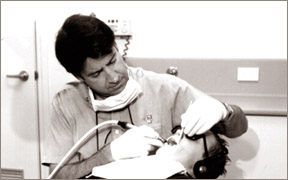Tremendous advancement in oral hygiene
by Shanika Sriyananda
 Good health habits - brushing teeth twice a day and wide public
awareness on taking care of teeth have made a significant progress in
dentistry in Sri Lanka. The tendency to consult a doctor even for a tiny
cavity on a tooth has showed a change and more people seek medical help
even for minor dental problems. Good health habits - brushing teeth twice a day and wide public
awareness on taking care of teeth have made a significant progress in
dentistry in Sri Lanka. The tendency to consult a doctor even for a tiny
cavity on a tooth has showed a change and more people seek medical help
even for minor dental problems.
According to a latest survey done in every district has revealed that
the oral hygiene among Sri Lankans has improved during the last decade.
"This is mainly because of the improved facilities and wide public
awareness on the importance of having healthy teeth", Deputy Director
Dental Institute of the Colombo National Hospital Dr. S. R. U.
Wimalaratne said.
 Dental Institute (DI), that old building with archaeological value,
built in 1927, is a bee hive during the day time and sometimes even at
night. Coming from the four corners of the country, over 111,000 new
patients had registered with the Institute last year. Dental Institute (DI), that old building with archaeological value,
built in 1927, is a bee hive during the day time and sometimes even at
night. Coming from the four corners of the country, over 111,000 new
patients had registered with the Institute last year.
Functioning with eight Consultants and 92 doctors, DI carries out
services in four major specialities of dentistry - Maxillo facial
surgery, Orthodontics, Restorative Dentistry and Community Dentistry.
Being one of the major institutes in Dentistry, the Colombo DI
provides almost all the major surgeries in dentistry. "We treat patients
with the simple tooth ache to major treatments like correction of
irregular teeth, which costs over Rs. 80,000 in private sector,
free-of-charge", Dr. Wimalaratne said.
OPD is the largest service unit in the Dental Institute. It consists
of an emergency treatment unit, and the 12 OPD clinics which function on
all working days of the week. OPD is the entry point to take treatment
at Dental Institute.
Screening of patients, provision of general dental treatments such as
extractions fillings, scaling, referral of needy patients to specialized
units are taken place at the OPD which is manned by non specialised
Dental Surgeons. On average about 700 patients including children are
given treatment at the OPD on a working day.
Dental and Maxillo-Facial Surgery Units (OMF units): There are 4 such
units functioning at present at the Dental Institute. Each unit is
staffed with a Consultant Mazillo-Facial Surgeon, a Senior House officer
and two House Officers.
In addition one or two postgraduate trainees are assigned to some
units. The patients with fractures in the oro-facial region, oral
carcinoma, dentofacial pathology and developmental anomalies are given
care at the OMF units. In a week each OMF unit provides outdoor clinic
services for five days and undertake routine operation list on a day.
Orthodontic Unit: There is only one Orthodontic unit at the Dental
Institute. This unit is staffed with a Consultant Orthodontist. The unit
deals with correction of various types of malocclusions, and cleft lip
and palate and other jaw deformities and provides services on all
working days of the week. Patients from all over the island are
attending this clinic.
There is a long waiting list for treatment and it extends up to year
2010.
Restorative Dentistry Units: There are 2 such units at Dental
Institute. Restorative, Periodontal, Padodontics and Prosthodontic
treatments are carried out in these specialist units. These units are
open for patients on all six working days of the week.
Community Dental Unit: Similar to other specialized units this unit
is staffed with a Consultant and provides services on all working days
of the week. This unit mainly deals with research, service and training
activities. The preventive dental clinic operating at the unit is the
only such clinic available at a government hospital in Sri Lanka.
The medical staff, including a dentist at the emergency treatment
unit at the DI, provides a 24-hour service. Patients with simple tooth
ache to swelling, tooth fractures to tooth injuries seek emergency
treatment.According to Dr. Wimalaratne, the DI is popular among the
public as it has all the facilities to treat any problem related to
dentistry.
"The number of patients has also increased due to the safety and the
sterilization process of the equipment of the DI. Now we have commenced
building of our own sterilization plant in the premises and it is under
the latest technology, which is used in developed countries", he said.
Preventing child abuse
by Dr. R. A. R. Perera
The most frequent form of violence in the home remains relatively
hidden from public scrutiny, is battering of a child by his or her
parents.Violence has long been a part of family life. A research
conducted by a social psychologist called Straus revealed that an
individual stands a greater chance of being struck and or injured by a
family member in the home that by anyone else in any other place.
At lease three major factors seem to be involved in these instances:
*Many psychologists believe that common stress is an important source
of child abuse. Stress from great many source piles up during the day,
and people often can do little to alleviate it. A worker cannot express
anger against an employer easily, for fear of being fired. Traffic
snarls allow drivers little in the way of retaliation.
 As a result, an exhausted and angry adult may engage in displacement
of aggression - that is, he or she may attack some target other than the
one that is producing the stress. As a result, an exhausted and angry adult may engage in displacement
of aggression - that is, he or she may attack some target other than the
one that is producing the stress.
Often the children are the targets of displacement not only because
they are available, but also because they are defenceless against
attack.
Studies have found statistical associations between various
indicators of stress and child abuse. A large proportion of mothers who
abused their children were experiencing economic stress and were without
supportive resources.
* Even when they are experiencing great stress, most adults would not
batter their children unless there were cultural sanctions for this kind
of behaviour. Adults do not, for example, attack their neighbour's
children or pets. Strong informal rules prohibit such actions. However,
beating one's own children is an action that has long been sanctioned in
the society.
Certain people are more likely to react to stress by battering their
children than any others. In some cases the aggressive parent may be
imitating models in his or her own family. A number of studies show that
many parents who abuse their children were themselves abused in
childhood or observed violent adult models.
However, modelling may not account for all incidents of child
beating. Many child abusers suffer from severe emotional problems or
other social problems such as social isolation.
If child abuse is to be reduced, one approach might be to attack the
cultural rules that sanction it. If physical punishment becomes socially
unacceptable, it is more likely to be monitored in the community and
reduced through shame.
Underfoot fractures help to detect osteoporosis
Early warning of osteoporosis may be underfoot unexplained fractures
of the foot may provide a new means of detecting osteoporosis in its
earliest stages, says researcher Rodney L. Tomczak of Ohio State
University. "This is important for the possible prevention of more
serious hip and spine fractures," said Tomczak, a podiatric surgeon and
assistant professor in the university's department of orthopedics.
Tomczak and colleagues followed 21 women and men who suffered from
small fractures of the metatarsals, or long foot bones. None of the
fractures was known to be caused by injury or repetitive movements that
might overstress the foot.
Some patients reported a sudden painful snap while walking; others
had unexplained nagging pain in their foot bones. To determine whether
osteoporosis might be an underlying cause of the fractures, Tomczak
conducted standard bone density testing.
He was surprised-as were his patients-to find "strong evidence" that
19 of the 21 had "significant bone loss." In nine patients the hidden
bone loss was high enough to be classified as osteoporosis in their hips
and spine.
The minor foot fractures were the "first outward sign of bone loss,"
said Tomczak, who presented his findings at the recent meeting of the
American College of Foot and Ankle Surgeons.
Osteoporosis, or porous bone disease, is a progressive but silent
deterioration of bone structure that can put a person at significantly
increased risk of serious, sometimes life-threatening, fractures.
There are about 1.5 million osteoporosis-related fractures annually
in the United States, including one million of the hip and spine,
according to the National Osteoporosis Foundation. An estimated 10
million Americans have osteoporosis, 80 percent of them women, and
another 18 million have low bone mass.
Tomczak recommended that bone density testing for osteoporosis be
considered for patients with unexplained foot fractures.
Obesity in children
Obesity describes being seriously overweight, to a degree that has
important implications for health.
Obesity in childhood is particularly important for many reasons - it
predicts whether a child will be obese in adult life and is linked to
childhood complications.
 What effects does it have? These include problems with the joints and
bones (such as slipped femoral epiphysis, bow legs), a condition called
benign intracranial hypertension (with headaches and eye changes),
hypoventilation (leading to drowsiness and poor performance during the
day, snoring, heart failure), gall bladder disease, polycystic ovary
syndrome, high blood pressure, high levels of blood fats, and diabetes.
There are also marked psychological effects leading to low self-esteem. What effects does it have? These include problems with the joints and
bones (such as slipped femoral epiphysis, bow legs), a condition called
benign intracranial hypertension (with headaches and eye changes),
hypoventilation (leading to drowsiness and poor performance during the
day, snoring, heart failure), gall bladder disease, polycystic ovary
syndrome, high blood pressure, high levels of blood fats, and diabetes.
There are also marked psychological effects leading to low self-esteem.
Symptoms of obesity range from tiredness, backache, headaches, joint
problems and poor sleep to problems at school, emotional difficulties
and psychological problems.
What causes it? Obesity is caused by two simple factors - an
unhealthy diet (typically too rich in sugar and fats) and not doing
enough exercise to burn off the calories consumed.
Occasionally, there are other factors, for example in a rare genetic
condition called Prader-Willi syndrome there may be problems with
controlling hunger. Hypothyroidism and Cushing's syndrome can also cause
obesity.
Who's affected? More and more children in the UK are becoming obese -
it's been described as a modern epidemic. About 20 per cent of children
are now overweight and 2.5 per cent are severely overweight or obese.
Research suggests that the main problem is a continual reduction in the
amount of exercise children take. Many overweight children have
overweight parents - it's often a matter of family lifestyles.
A child's BMI is calculated using the same method as for adults -
weight in kilograms divided by height in metres squared - but adult BMI
figures must not be used to determine whether a child is overweight or
obese. Specific age-adjusted charts are needed.
If you're worried that your child is overweight, talk to your doctor
and ask for help from a dietician. Avoid starting your child on an
aggressive diet. Instead, make long-term changes to healthy eating for
all the family, and get your child involved in sport or exercise. Aim to
increase their intake of fresh fruit and vegetables (they should be
having five portions a day and reduce fat intake.
Try to find healthy snacks they like, and sit down together at least
once a day for a balanced meal. Talk to teachers at their school about
what can be done there. Because being overweight is often a family
problem, measure the BMI of everyone in the family, and start making
changes together for a healthy family lifestyle.
BBC Health
Reply to Dr. Atukorale :
AAMS epidemic
I am very grateful to Dr. D.P. Atukorale for the letter written to
the Sunday Observer few weeks ago with reference to the recent article
on Accelerated Atherocoronary Metabolic Syndrome.
It is encouraging to observe a real dialogue on this syndrome, which
of serious national concern, building amongst the major stakeholders in
the field of cardiology in Sri Lanka. It is anticipated that such a
dialogue would facilitate greater national interest leading to more
public awareness and badly needed major policy changes in the healthcare
sector.
The said article clearly highlighted the lack of data and original
research work on this issue that has been generated from within Sri
Lanka. However there has been some research work that has been carried
out in the West on Sri Lankan expatriates that makes the relevance of
the facts highlighted in the article to the local context.
However there has been some large scale research carried out amongst
people of southern Asian origin living in many countries in the West as
well as some developing countries like Fiji, Mauritius and the West
Indies.
In my article I stated that the traditional risk factors amongst
southern Asians though common, are not as prevalent as amongst the white
Caucasians and the relative disease incidence and prevalence amongst the
Southern Asian ethnics is out of proportion to the prevalence of those
risk factors.
This is a fact that has been repeatedly observed in scientific
investigations. (Enas et al. Indian Heart Journal 1996;48:343-353,
Chadda et. al Indian Journal of Medical Research 1990;92(B):424-430,
Begom et al. Acta Cardiologica 1995;3:227-240). This fact was further
confirmed by an epidemiological study I conducted amongst three Sri
Lankan population cohorts from rural Sri Lanka, urban Sri Lanka and
Sydney Australia (Heart Foundation of Australia 1994).
In a similar manner the precise prevalence of the novel coronary risk
factors such as hyperhomocysteinaemia and high LP(a) levels in Sri Lanka
has not been clearly described due to the lack of original research and
the prohibitively high cost of routinely carrying out these
investigations in local coronary patients.
However many scientific articles have been published testifying to
its very high prevalence amongst South Asians including Sri Lankans.
Some studies have demonstrated a prevalence of more than 75% of
hyperhomocysteinaemia in India (Refsum et al. American Journal of
Clinical Nutrition 2001;74:233-241).
Many studies have also highlighted the presence of high levels of
LP(a) in many Asian Indians from different parts of the world. (Enas
et.al.Indian Heart Journal, 1994;46 suppl:185(abstract), Chuang et al.
Indian Heart Journal 1998;50:285-291, Low et al. Paediatric Research
1996;40:718-722). The high prevalence of these risk factors seems to
better correlate with the high prevalence of coronary artery disease
among Southern Asians in comparison to the white Caucasians.
It is important to note that epidemiological and clinical (including
the angiographic appearance of the coronary anatomy) features of
coronary artery disease among South Asian populations do not seem to
vary across geographic locations.
Thus it is scientifically rational to project what is widely observed
in similar populations elsewhere to the Sri Lankan context.
Anecdotal evidence suggests that there is low HDL levels in some Sri
Lankans and this is no different to that in white Caucasians. Thus once
again this risk factor per se does not explain the high prevalence of
CAD in Sri Lanka.
It is well agreed that there is a critical paucity of original
research carried out amongst Sri Lankans living in Sri Lanka. This fact
highlights the pressing need for original studies to be carried out at
the earliest, giving this a high priority in the health care agenda of
the country.
It is very likely that once original data is generated within the
country it would mirror those generated amongst Sri Lankans and South
Asians from elsewhere due to the shared traditional gene pool of the
South Asian (Asian Indian) race and their shared socio-cultural and
environmental factors.
It should be noted that the epidemic of AAMS associated coronary
disease is not confined to Sri Lanka but common to all South Asians
world-wide. The call of the hour is to establish a consensus that there
is a epidemic of coronary artery disease in Sri Lanka just as it is in
South Asians (Asian Indians) all over the world and based on this
conviction to investigate the true causative factors behind this and
device appropriate remedies and therapeutics.
Investigative and therapeutic principles developed to manage heart
disease in the White Caucasian have failed to control the spread of the
AAMS epidemic and the resultant heart disease in the South Asian.
Therefore it is important to acknowledge the unique nature of this
disorder and navigate the future strategies at curbing this disorder
guided by this fact.
(Rohan Jayasinghe, Professor of Cardiology, School of Medicine,
Australia.)
[email protected]
|
